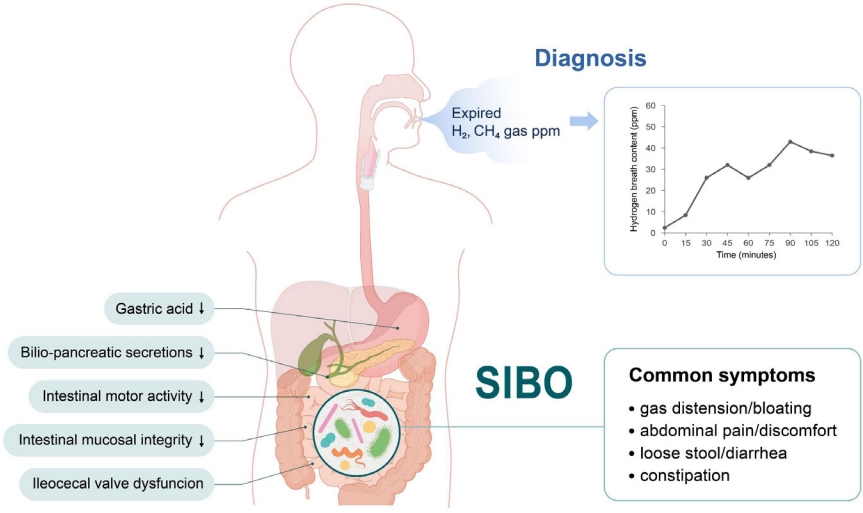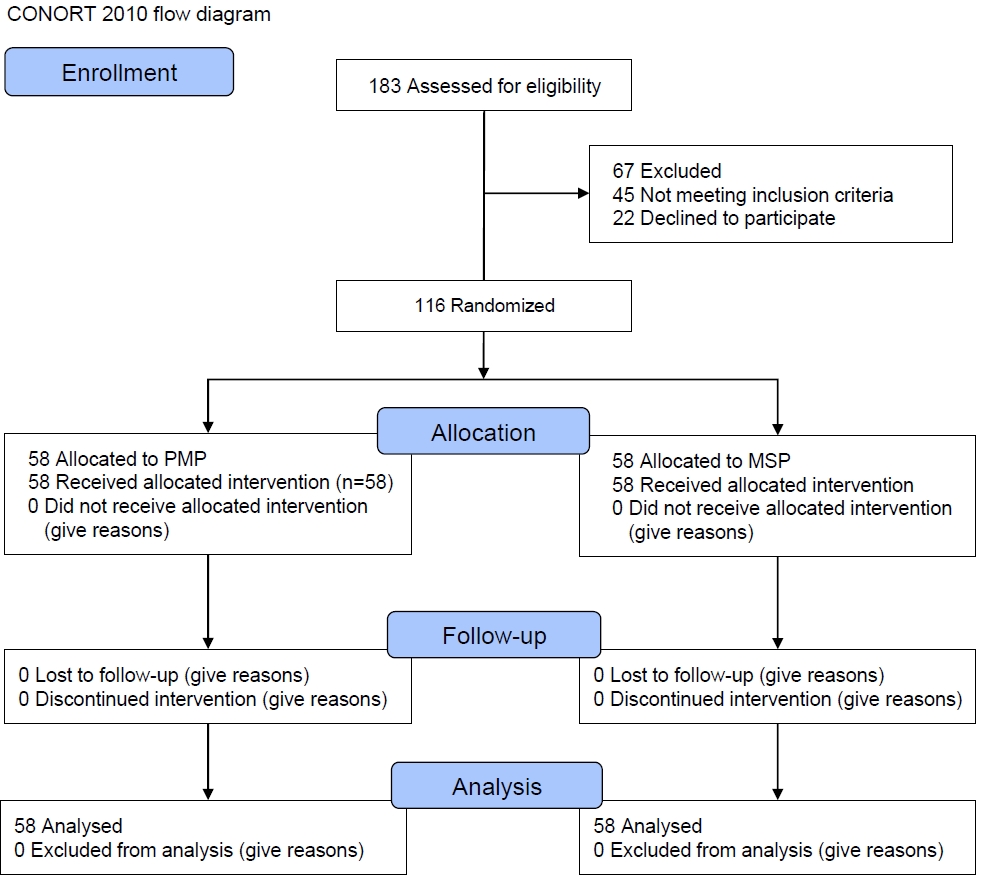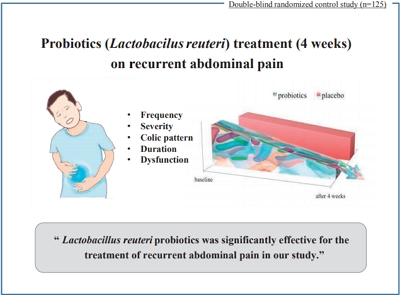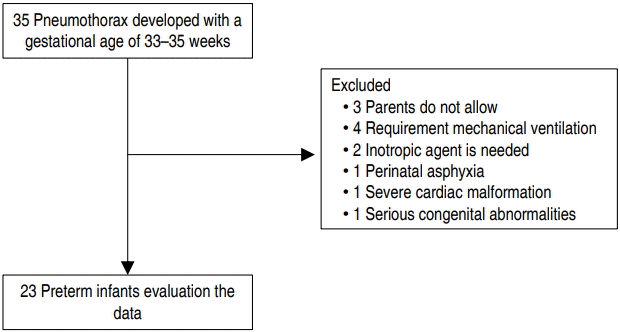Search
- Page Path
-
- HOME
- Search
- Review Article
- Gastroenterology
- Prevalence, risk factors, and treatment of small intestinal bacterial overgrowth in children
- Yu Kyung Cho, Jin Lee, Chang Nyol Paik
- Clin Exp Pediatr. 2023;66(9):377-383. Published online August 21, 2023
-

· Pediatric small intestinal bacterial overgrowth (SIBO) manifestations range from nonspecific abdominal symptoms to malabsorption or malnutrition.
· SIBO is prevalent in children and adolescents with functional abdominal pain disorders.
· Predisposing factors include disturbed intestinal motility, altered anatomy, and/or abnormal body defense systems against intestinal bacteria.
· Breath tests are safe and noninvasive.
· Treatment principles include managing predisposing conditions, nutritional support, symptom control, and antibiotics.
- Original Article
- General Pediatrics
- Virtual reality for pain reduction during intravenous injection in pediatrics: a systematic review and meta-analysis of controlled clinical trials
- Ensiyeh Jenabi, Saeid Bashirian, Amir Mohammad Salehi, Masoud Rafiee, Mozhdeh Bashirian
- Clin Exp Pediatr. 2023;66(12):533-537. Published online June 14, 2023
-

Question: This is the first meta-analysis to examine published evidence of the effectiveness of virtual reality at reducing pain during pediatric intravenous injections.
Finding: Our results suggest that virtual reality effectively reduces pain associated with intravenous injections in pediatric patients.
Meaning: These findings suggest the importance of virtual reality in decreasing the pain of intravenous injections among children.
- Gastroenterology
- Ability of polymicrobial probiotic and mono-strain probiotic to reduce functional abdominal pain in children: a randomized clinical trial
- Seyed Sajad Jafari, Seyed Mojtaba Hashemi, Bahman Sadeghi, Amir Almasi-Hashiani
- Clin Exp Pediatr. 2022;65(12):589-594. Published online October 31, 2022
-

· This study compared the ability of 2 probiotics to reduce and improve functional abdominal pain (FAP) in children.
· In the polymicrobial probiotic (PMP) group, 10.34% of children reported no pain; in the mono-strain probiotic (MSP) group, all patients reported low-degree pain. The mean pain score decreased significantly over time in both groups.
· The use of both PMP and MSP is recommended to reduce pain in patients with FAP.
- Evaluating the effects of probiotics in pediatrics with recurrent abdominal pain
- Parisa Rahmani, Azin Ghouran-orimi, Farzaneh Motamed, Alireza Moradzadeh
- Clin Exp Pediatr. 2020;63(12):485-490. Published online July 21, 2020
-

Question: ecurrent abdominal pain (RAP) is a chief complaint among pediatrics and is associated with reduced quality of life, for both parent and child, and economic burden. Does probiotics reduce the frequency of RAP among children?
Finding: This study reported the effects of Lactobacillus reuteri probiotics among children with RAP as a result of multiple etiologies.
Meaning: The administration of probiotic supplements is significantly associated with pain relief among RAP children presented with functional abdominal pain, irritable bowel syndrome, and functional dyspepsia.
- Neonatology (Perinatology)
- Evaluation of prolonged pain in preterm infants with pneumothorax using heart rate variability analysis and EDIN (Échelle Douleur Inconfort Nouveau-Né, neonatal pain and discomfort scale) scores
- Mehmet Buyuktiryaki, Nurdan Uras, Nilufer Okur, Mehmet Yekta Oncel, Gulsum Kadioglu Simsek, Sehribanu Ozluer Isik, Serife Suna Oguz
- Clin Exp Pediatr. 2018;61(10):322-326. Published online September 16, 2018
-

Purpose: The EDIN scale (Échelle Douleur Inconfort Nouveau-Né, neonatal pain and discomfort scale) and heart rate variability has been used for the evaluation of prolonged pain. The aim of our study was to assess the value of the newborn infant parasympathetic evaluation (NIPE) index and EDIN scale for the evaluation of prolonged pain in preterm infants with chest tube placement...
- Case Report
- Neurology
- Painful legs and moving toes syndrome in a 16-year-old girl
- Seung Soo Kim, Yong Seung Hwang, Young Chang Kim
- Clin Exp Pediatr. 2016;59(9):381-383. Published online September 21, 2016
-
Painful legs and moving toes (PLMT) syndrome is characterized by spontaneous movements of the digits and pain in one or both lower extremities. Of the reported cases, a majority of the patients was female, and the mean age of onset was 58 years. Only one pediatric case has been reported so far. Herein, we report the first adolescent case of...
Diphyllobothrium latum infection in a child with recurrent abdominal pain- Seung Hyun Lee, Hyun Park, Seung Taek Yu
- Clin Exp Pediatr. 2015;58(11):451-453. Published online November 22, 2015
-
Diphyllobothrium latum infection in humans is not common in Republic of Korea. We report a case of fish tapeworm infection in a 10-year-old boy after ingestion of raw perch about 8 months ago. The patient complained of recurrent abdominal pain and watery diarrhea. A tapeworm, 85 cm in length, without scolex and neck, was spontaneously discharged in the feces of...
- Original Article
- Analysis of clinical characteristics and causes of chest pain in children and adolescents
- Ji Hye Chun, Tae Hyeong Kim, Mi Young Han, Na Yeon Kim, Kyung Lim Yoon
- Clin Exp Pediatr. 2015;58(11):440-445. Published online November 22, 2015
-
Purpose Chest pain is common in children and adolescents and is a reason for referral to pediatric cardiologists. Although most cases of chest pain in these age groups are benign and do not require treatment, timely diagnosis is important not to miss life-threatening diseases requiring prompt treatment. We investigated certain clinical characteristics that may be useful in the diagnosis of such...
- The effect of sucrose on infants during a painful procedure
- Kyoung Hwa Joung, Soo Chul Cho
- Clin Exp Pediatr. 2010;53(8):790-794. Published online August 31, 2010
-
Purpose The purpose of this study was to test the efficacy of treating the pain among newborn infants associated with a medical procedure with sucrose with regard to overall physiological and behavioral stability.
Methods 103 newborn infants were enrolled in this study. The control group (n=63) did not receive any treatment. The experimental group (n=40) received 2 mL of 24% sucrose solution two...
- Case Report
- A case of restless legs syndrome in a child presenting with growing pains
- Dong Soon Kim, Hong Beom Shin, Young Min Ahn
- Clin Exp Pediatr. 2008;51(11):1222-1227. Published online November 15, 2008
-
Restless legs syndrome (RLS) is a common neurological sleep disorder in adults characterized by the following diagnostic criteria: an urge to move that is usually associated with unpleasant sensations and symptoms that are worse at rest, relieved by movement, and most severe at night. The definite diagnosis of RLS in children is stricter and consists of self-description of leg discomfort... -
- Review Article
- Malignancies in children who present with bone pain
- Jun Ah Lee
- Clin Exp Pediatr. 2008;51(8):792-796. Published online August 15, 2008
-
Bone pain in a child could be associated with cancer as an initial manifestation of the disease. The childhood malignancies that frequently present bone pain are leukemia, neuroblastoma, and primary bone tumors such as osteosarcoma and Ewing sarcoma. Persistent bone or joint pain associated with swelling, mass, or limitation of motion implies underlying serious causes. Systemic manifestations such as lymphadenopathy,... -
- Original Article
- Pain reducing effect of vapocoolant spray during injection and heelstick procedure in neonates
- Eun Kyong Choi, Ji Mi Jung, Jong Beom Sin
- Clin Exp Pediatr. 2008;51(5):481-486. Published online May 15, 2008
-
Purpose : The aims of this study were to test the efficacy of vapocoolant spray to decrease the symptoms associated with pain in newborns undergoing heel stick and intramuscular injection and compare the pain relief effect of oral glucose. Methods : Randomized, controlled study including sixty newborns undergoing heel stick and intramuscular injection. Group 1 was heelsticked, Group 2 was intramuscular... -
- Characteristics of functional gastrointestinal disorders in children with chronic abdominal pain
- Ji Hyun Uhm
- Clin Exp Pediatr. 2007;50(7):655-659. Published online July 15, 2007
-
Purpose : The aim of this study was to document the causes of chronic abdominal pain in children referred to a hospital setting and evaluate the frequency and characteristics of functional gastrointestinal disorder (FGID) classified by Rome III criteria. Methods : One hundred thirty two patients with chronic abdominal pain were evaluated. Examinations were performed in order to find organic... -
- Case Report
- A case of Tolosa-Hunt syndrome
- Do Gyun Kim, Young Ok Kim, Young Jong Woo
- Clin Exp Pediatr. 2006;49(6):696-699. Published online June 15, 2006
-
소아에서 드물게 보고되는 토로사-헌트 증후군은 둔하면서 지속적인 안와 주위의 통증과 안구운동 장애 및 해면동 주위의 뇌신경 침범을 특징으로 하는 질환으로 비특이적 염증조직에 기인한 것으로 알려져 있다. 이는 자연 치유도 가능하나 대개 스테로이드가 증상의 회복에 효과적이며 신속한 호전을 유도한다. 토로사-헌트 증후군은 그 예후가 양호하다고 알려져 있으나 일부는 치료 후에 재발하기도 한다. 우리는 토로사-헌트 증후군으로 진단받고 스테로이드 치료 후 특별한 휴우증 없이... -
- Original Article
- Pain reduction at venipuncture in newborn infants : oral glucose solution, EMLA cream and pacifiers
- Sang Kee Park, Eun Young Kim
- Clin Exp Pediatr. 2006;49(4):388-393. Published online April 15, 2006
-
Purpose : We compared the pain reducing effect of orally administered glucose solution with EMLA cream and pacifiers during venipuncture in newborn infants. Methods : Fifty newborn infants(30 prematures) were enrolled in this study. We performed these four pain-reducing methods to all infants in serial order. Group A(control) did not receive any treatment; to group B, EMLA cream was applied on... -
- Helicobacter pylori reinfection rate by a 13C-urea breath test and endoscopic biopsy tests in Korean children
- Jeong Ok Shim, Jeong Kee Seo
- Clin Exp Pediatr. 2006;49(3):268-272. Published online March 15, 2006
-
Purpose : The reinfection rate of H. pylori reported before 13C-urea breath test(13C-UBT) era was higher than that of the post 13C-UBT era. Children are usually reluctant to receive invasive endoscopic evaluation for the reinfection of H. pylori, particularly when they are asymptomatic. The aim of the study is to discover the reinfection rate by different diagnostic tests, and to... -
- Review Article
- Helicobacter pylori infection and abdominal pain in children
- Jeong Kee Seo
- Clin Exp Pediatr. 2006;49(2):136-143. Published online February 15, 2006
-
The relationship between H. pylori(Hp) infection and recurrent abdominal pain(RAP) in children is not clear. Current data in the literature regarding a causal relationship between Hp infection and childhood RAP are conflicting. However, meta-analysis and most of the recently published studies have not supported an association between Hp infection and an increased prevalence of abdominal pain. Most published studies have... -
- New approach to chronic recurrent abdominal pain in children
- Hye Ran Yang
- Clin Exp Pediatr. 2006;49(2):129-135. Published online February 15, 2006
-
Chronic recurrent abdominal pain is a common manifestation in children. Functional abdominal pain is the most common cause of chronic abdominal pain and can be diagnosed properly by the physician without the requirement of specific evaluation when there are no alarm symptoms or signs. Functional abdominal pain is categorized as functional dyspepsia, irritable bowel syndrome, functional abdominal pain, abdominal migraine,... -
- Early recognition of high risk factors of acute abdominal pain in children
- Jin-Bok Hwang
- Clin Exp Pediatr. 2006;49(2):117-128. Published online February 15, 2006
-
Non-traumatic acute abdominal pain in children presents a diagnostic dilemma. Numerous disorders can cause abdominal pain. Although many etiologies are benign, some require a rapid diagnosis and treatment in order to minimize morbidity. This review concentrates on the clinical office evaluation of acute abdominal pain in infants and children and details the clinical guideline for the diagnostic approach to imaging... -
- Case Report
- Two Cases of Lead Poisoning due to Herb Medicinal Pills
- Seong Hwan Choi, Eun Young Park, Jung Yeon Shim, Deok Soo Kim, Jae Won Shim, Hye Lim Jung, Moon Soo Park
- Clin Exp Pediatr. 2005;48(9):1009-1015. Published online September 15, 2005
-
We encountered two children with lead poisoning who were administered herb medicinal pills recommended by their clergyman. These patients presented anemia and severe coliky abdominal pain, but no neurologic symptoms. For this reason, they were initially misdiagnosed with gastrointestinal hemorrhagic disease. However, we got a clue that they took herb medicinal pills. Finally, based on the assay of blood lead... -
- A Case of Trichobezoar in a Child Who Visited with Intermittent Abdominal Pain, Nausea and Vomiting
- Seung-In Ahn, Jung-Suk Yoo, Kyung-Chang Oh, Bong-Lim Kim, Sung-Sub Kim, Yeun-Ho Kim, Jin-Keun Chang
- Clin Exp Pediatr. 2005;48(4):433-437. Published online April 15, 2005
-
Bezoars are concretions commonly found in the stomach and small bowel, and four types of bezoars have been described based on their composition : trichobezoar, phytobezoar, lactorbezoar, and miscellaneous. Bezoars most often develop after gastric operations that alter the motility, emptying, and grinding of food in the stomach. Trichobezoars are most common in female children with normal gastrointestinal function and... -
- A Case of Bronchogenic Cyst with Nausea and Epigastric Pain
- Ji-Hyun Kim, Kang-Won Rhee, In-Seok Lim, Byung-Hoon Yoo, Eung-Sang Choi
- Clin Exp Pediatr. 2005;48(3):333-336. Published online March 15, 2005
-
Bronchogenic cysts are rare congenital anomalies that arise early in gestation from abnormal budding of the developing respiratory system. Mediastinal bronchogenic cysts account for 10-15 percent of all primary mediastinal masses; 63.7 percent of patients are symptomatic. Common symptoms are fever, chest pain, cough, dyspnea, and dysphagia. Gastrointestinal symptoms except dysphagia are rare. It can be life threatening with compression,... -
- Original Article
- A Clinical Study on Relationship of Surgical Glove and Back Pain after Lumbar Puncture in Children
- Sung Ryoung Han, Wan Suk Choi, Hae Jeong Lee, Hyun Seok Kim, Ju Suk Lee, Kyung Lae Cho
- Clin Exp Pediatr. 2005;48(3):310-314. Published online March 15, 2005
-
Propose : In this study, we evaluated whether powder on surgical gloves is a cause of postpuncture backpain in children. Mothods : In 164 children with meningitis between July and September 1997, we did not remove powder from surgical gloves. However, in 149 children with menigitis between May and October 2001 the powder was removed from the surgical gloves. Results : Out... -
- Case Report
- A Case of Solitary Rectal Ulcer Syndrome
- Won Ho Hahn, Eun Seong Kim, Hyo Jong Kim, Sung Ho Cha
- Clin Exp Pediatr. 2004;47(8):896-899. Published online August 15, 2004
-
Solitary rectal ulcer syndrome(SRUS) is a rare disorder in children. The incidence of SRUS is highest in young adults, and sex distribution is equal, or there may be a slight female predominance. There are few investigations about the exact incidences and effective treatment protocols of SRUS in children. The clinical symptoms and signs of SRUS are accompanied by rectal bleeding,... -
- Original Article
- Etiologic Diagnosis and Clinical Characteristics of Chronic Recurrent Chest Pain in Children
- Eun-Jung Choi, Eun-A Lee, Chang-Woo Lee, Du-Young Choi, Yeon-Geun Oh, Jong-Duk Kim, Hyang-Suk Yoon
- Clin Exp Pediatr. 2004;47(6):628-633. Published online June 15, 2004
-
Purpose : To identify the causes and clinical characteristics, and the efficacy of various diagnostic approaches, we studied, prospectively, pediatric patients with chronic recurrent chest pain. Methods : A prospective study of 122 patients with chronic recurrent chest pain from June 1998 to June 2003 was performed. The male and female ratio was 81 : 41, age 9.3?.1 year. A... -
- Is Acute Nonspecific Mesenteric Lymphadenitis Associated with Acute Abdominal Pain in Epidemic Aseptic Meningitis?
- Hae Rim Kim, Kiyoung Ku, Young Hwan Lee, Sin Kam, Jin-Bok Hwang
- Clin Exp Pediatr. 2004;47(6):623-627. Published online June 15, 2004
-
Purpose : Acute abdominal pain in an epidemic aseptic meningitis which is mostly an enterovirus as causative agent, is noted in 23-55% of patients. An enterovirus is also known as one of the causes of acute nonspecific mesenteric lymphadenitis(ANML). The purpose of this study was to see if ANML was associated with acute abdominal pain in epidemic aseptic meningitis. Methods :... -
- Therapeutic Effect of Helicobacter pylori Eradication in Children with Recurrent Abdominal Pain Associated with H. pylori
- Ji Hyun Uhm, Ki Sup Chung
- Clin Exp Pediatr. 2004;47(5):547-554. Published online May 15, 2004
-
Purpose : In order to clarify the role of Helicobacter pylori(H. pylori) in recurrent abdominal pain, we investigated prospectively the effect of eradication of H. pylori based on symptom improvement in children with recurrent abdominal pain. Methods : Children with recurrent abdominal pain were evaluated with diagnostic upper gastrointestinal endoscopy to rule out peptic ulcer disease, etc. During endoscopy, biopsies were... -
- A Multivariate Analysis of Risk Factors of Renal Involvement in Henoch-Sch nlein Purpura
- Min Jee Jeoung, Hyung Eun Yim, Kee Hwan Yoo, Young Sook Hong, Joo Won Lee, Soon Kyum Kim
- Clin Exp Pediatr. 2004;47(4):405-411. Published online April 15, 2004
-
Purpose : Long-term prognosis of Henoch-Sch nlein purpura(HSP) is determined by the existence and severity of renal involvement. We evaluated the relationship between various clinical features of HSP and the development of renal involvement using univariate and multivariate analyses for early detection and proper management of HSP nephritis. Methods : We performed a retrospective study of 200 children who were diagnosed... -
- Clinical Evaluation and Diagnosis of Children with Chest Pain
- Su A Shin, Yong Joo Kim, Jae Whan Lee, Nam Su Kim, Soo Ji Moon
- Clin Exp Pediatr. 2003;46(12):1248-1252. Published online December 15, 2003
-
Purpose : Chest pain in the pediatric population is not rare and mostly benign. Causes of chest pain are diverse, and differential diagnosis is not easy. Chest pain in children is less likely to be cardiac in origin. Furthermore, chest pain in the pediatric population is rarely associated with life-threatening disease. This study was designed to evaluate children with chest... -
- Changes of c-Fos Immunoreactivity in Midbrain by Deep Pain and Effects of Aspirin
- Jin A Jung, Ki Soo Yoo, Kyu Keun Hwang
- Clin Exp Pediatr. 2003;46(7):695-701. Published online July 15, 2003
-
Purpose : It had been suggested that pain arising from deep somatic body regions influences neural activity within periaqueductal gray(PAG) of midbrain via distinct spinal pathways. Aspirin is one of the popular non-steroidal anti-inflammatory drugs used in the management of pain. Fos expression was used as a marker for neuronal activity throughout central neurons following painful peripheral stimulation. This study... -
-

-
-

-

-
Impact Factor3.2
-
8.02023CiteScore94nd percentilePowered by







